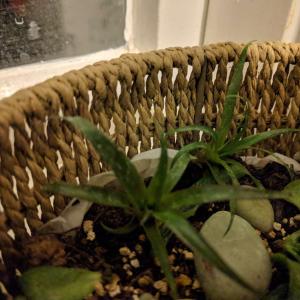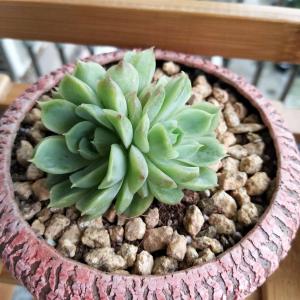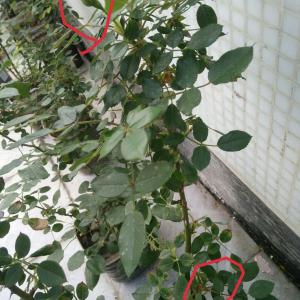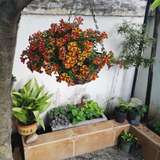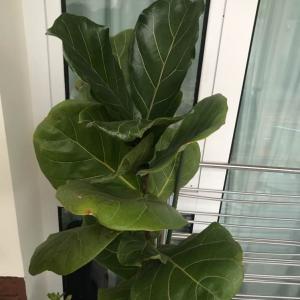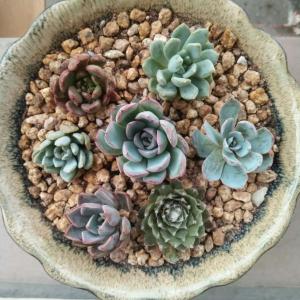文章
Miss Chen
2018年05月05日

Description: This perennial plant is about ¾-2' tall and unbranched or little branched. Scattered white hairs occur occasionally along the central stem, although it becomes glabrous with age. The opposite leaves are up to 5" long and 3" across (excluding the petioles); they are ovate-cordate, dentate along their margins, and largely hairless. The upper leaf surface is medium to dark green and hairless. The slender petioles of the leaves are up to 1½" long and medium green. The central stem terminates in a raceme of flowers up to 6" long. The stalk of this raceme has scattered white hairs. The small flowers are sparsely, but evenly, distributed along this stalk on slender pedicels up to ½" long. These pedicels spread outward.
Each flower consists of 2 white petals, 2 green sepals, 2 stamens, and a slender style. Each petal is deeply divided into 2 lobes. At the base of each flower, there is a 2-celled ovary that is green and covered with stiff hooked hairs; it is obovoid in shape. Each cell of this ovary contains a single seed. The blooming period for a colony of plants occurs during the summer and lasts about a month. Each flower is short-lived and replaced by a small bur-like fruit (see the description of the ovary above). The root system can produce rhizomes or stolons that extend through the soil or leaf mould to create clonal offsets from the mother plant.
Cultivation: The preference is dappled sunlight to medium shade, more or less mesic conditions, and a rich loamy soil with abundant organic matter.

Range & Habitat: The native Enchanter's Nightshade is an occasional to locally common plant that occurs in most counties of Illinois (see Distribution Map). This plant may be less abundant than in the past because of browsing by deer. Habitats include mesic deciduous woodlands, including oak woodlands and maple/basswood woodlands, and areas that are adjacent to woodland paths. Sometimes this species occurs in wooded upland areas and along ravine slopes.
Faunal Associations: The nectar and pollen of the flowers attract small bees, including Halictid bees (Lasioglossum spp.) and little carpenter bees (Ceratina spp.); they are also visited by Syrphid flies and bee flies (Bombyliidae). The caterpillars of a moth, Mompha terminella (Enchanter's Cosmet), are blotch leaf-miners. Birds and mammals help to distribute the seeds, as the small bur-like fruits can cling to feathers and fur; these fruits can cling to the clothing of humans as well. Deer occasionally browse on the foliage of Enchanter's Nightshade.

Photographic Location: A mesic deciduous woodlands at Busey Woods in Urbana, Illinois.
Comments: This is one of the woodland wildflowers that blooms during the summer in shaded areas. The flowers of such species are usually small, white, and not very showy. Enchanter's Nightshade is a rather odd member of the Evening Primrose family, as its flowers have only 2 petals, 2 sepals, and 2 stamens. This is a distinctive characteristic of the Circaea genus in this family. The only other member of this genus that occurs in Illinois, Circaea alpina (Small Enchanter's Nightshade), is an uncommon species that is restricted to the cool moist woodlands of northern Illinois. It has leaves that are more cordate and indented at the base, and its flowers are clustered toward the apex of the flowering stalk (rather than being evenly distributed along this stalk). While Enchanter's Nightshade is ¾-2' tall and it has 2-celled ovaries, Small Enchanter's Nightshade is less than 1' tall and it has 1-celled ovaries.
Each flower consists of 2 white petals, 2 green sepals, 2 stamens, and a slender style. Each petal is deeply divided into 2 lobes. At the base of each flower, there is a 2-celled ovary that is green and covered with stiff hooked hairs; it is obovoid in shape. Each cell of this ovary contains a single seed. The blooming period for a colony of plants occurs during the summer and lasts about a month. Each flower is short-lived and replaced by a small bur-like fruit (see the description of the ovary above). The root system can produce rhizomes or stolons that extend through the soil or leaf mould to create clonal offsets from the mother plant.
Cultivation: The preference is dappled sunlight to medium shade, more or less mesic conditions, and a rich loamy soil with abundant organic matter.

Range & Habitat: The native Enchanter's Nightshade is an occasional to locally common plant that occurs in most counties of Illinois (see Distribution Map). This plant may be less abundant than in the past because of browsing by deer. Habitats include mesic deciduous woodlands, including oak woodlands and maple/basswood woodlands, and areas that are adjacent to woodland paths. Sometimes this species occurs in wooded upland areas and along ravine slopes.
Faunal Associations: The nectar and pollen of the flowers attract small bees, including Halictid bees (Lasioglossum spp.) and little carpenter bees (Ceratina spp.); they are also visited by Syrphid flies and bee flies (Bombyliidae). The caterpillars of a moth, Mompha terminella (Enchanter's Cosmet), are blotch leaf-miners. Birds and mammals help to distribute the seeds, as the small bur-like fruits can cling to feathers and fur; these fruits can cling to the clothing of humans as well. Deer occasionally browse on the foliage of Enchanter's Nightshade.

Photographic Location: A mesic deciduous woodlands at Busey Woods in Urbana, Illinois.
Comments: This is one of the woodland wildflowers that blooms during the summer in shaded areas. The flowers of such species are usually small, white, and not very showy. Enchanter's Nightshade is a rather odd member of the Evening Primrose family, as its flowers have only 2 petals, 2 sepals, and 2 stamens. This is a distinctive characteristic of the Circaea genus in this family. The only other member of this genus that occurs in Illinois, Circaea alpina (Small Enchanter's Nightshade), is an uncommon species that is restricted to the cool moist woodlands of northern Illinois. It has leaves that are more cordate and indented at the base, and its flowers are clustered toward the apex of the flowering stalk (rather than being evenly distributed along this stalk). While Enchanter's Nightshade is ¾-2' tall and it has 2-celled ovaries, Small Enchanter's Nightshade is less than 1' tall and it has 1-celled ovaries.
0
0
文章
Miss Chen
2018年05月04日

Description: This plant is a winter annual or biennial up to 2½' tall that branches occasionally. A few basal leaves are produced during the fall, while alternate cauline leaves develop along the stems during the following spring. The stems are green, glabrous, and terete. The leaves are up to 4" long and ¾" across; they are pinnately compound with 3-15 leaflets. The leaflets are linear, oblanceolate, obovate, or orbicular in shape, becoming more narrow on the upper leaves; their margins are usually undulate, shallowly lobed, or dentate with a few blunt teeth. On each leaf, the terminal leaflet is as wide or wider than the remaining leaflets. Both the lower and upper sides of the leaves are green and glabrous. The upper stems terminate in racemes of small white flowers.
Each flower is about 3 mm. (1/8") long, consisting of 4 white petals, 4 light green sepals, a stout pistil, and several stamens. The mature pedicels (5-9 mm. in length) ultimately become longer than the flowers. Both the pedicels and the central stalk (rachis) of the raceme are green and glabrous. The blooming period occurs from mid-spring to early summer and lasts about 1-2 months. Each flower is replaced by a narrowly cylindrical seedpod (or silique) that is up to 1¼" long. The siliques are relatively straight and they spread outward slightly from the central stalk of each raceme. The tips of young siliques often surround the flowers and partially obscure them. Each silique contains a row of tiny seeds; these seeds are about 1 mm. in length, oblongoid-ovoid in shape, and brown. The root system consists of a tuft of shallow fibrous roots. This plant spreads by reseeding itself.

Cultivation: The preference is light shade to partial sun, wet to moist conditions, and soil containing loam or sandy loam with decaying organic matter. This plant develops quickly during the spring when the weather is cool and moist.
Range & Habitat: The native Pennsylvania Bitter Cress occurs occasionally in most areas of Illinois; it tends to be less common or absent in the NW corner of the state (see Distribution Map). Habitats include wet to mesic deciduous woodlands (especially floodplain and bottomland woodlands), swamps, shady seeps and springs, the bottom of cliffs, low ground near streams, and areas along woodland paths. Pennsylvania Bitter Cress is occasionally found in slow-moving water of seasonal ditches and shallow streams, where it resembles an emergent-aquatic plant. This plant is found in both higher quality habitats and disturbed areas where there is partial to light shade and the ground is more or less moist. It is sometimes found in sandy areas where decaying organic material is abundant.

Faunal Associations: Occasionally, small bees or flower flies (Syrphidae) visit the flowers, otherwise they attract few visitors. Caterpillars of the moth Evergestis pallidata (Purple-Backed Cabbage Worm) are known to feed on the foliage of Cardamine spp. (Bitter Cresses), while caterpillars of the butterfly Anthocharis midea (Falcate Orangetip) feed on the flowers, buds, and developing seedpods of these plants. Two aphids, Myzus cerasi (Black Cherry Aphid) and Rhopalosiphonius staphyleae (Mangold Aphid), use these plants as summer hosts. Information about floral-faunal relations for vertebrate animals is currently unavailable.
Photographic Location: Near or in a stream of a sandy woodland at the Indiana Dunes State Park in NW Indiana.

Comments: This spring wildflower of woodlands is not very showy and it is often overlooked. This plant has a similar appearance to other Bitter Cresses (Cardamine spp.) with small white flowers, including Cardamine hirsuta (Hairy Bitter Cress) and Cardamine parviflora arenicola (Small-Flowered Bitter Cress). Hairy Bitter Cress, an introduced species, is hairy toward the base and it has abundant basal leaves while the flowers are blooming. Pennsylvania Bitter Cress has very few, if any, basal leaves while the flowers are blooming, and its foliage is completely hairless (at least in Illinois). Small-Flowered Bitter Cress is usually a little smaller in size than Pennsylvania Bitter Cress and it has more narrow leaflets (up to ¼" across). The terminal leaflets of this species are about the same size as the non-terminal leaflets. Small-Flowered Bitter Cress is usually found in habitats that are drier and sunnier than Pennsylvania Bitter Cress, although it is occasionally found in moist woodlands and wetlands as well.
Each flower is about 3 mm. (1/8") long, consisting of 4 white petals, 4 light green sepals, a stout pistil, and several stamens. The mature pedicels (5-9 mm. in length) ultimately become longer than the flowers. Both the pedicels and the central stalk (rachis) of the raceme are green and glabrous. The blooming period occurs from mid-spring to early summer and lasts about 1-2 months. Each flower is replaced by a narrowly cylindrical seedpod (or silique) that is up to 1¼" long. The siliques are relatively straight and they spread outward slightly from the central stalk of each raceme. The tips of young siliques often surround the flowers and partially obscure them. Each silique contains a row of tiny seeds; these seeds are about 1 mm. in length, oblongoid-ovoid in shape, and brown. The root system consists of a tuft of shallow fibrous roots. This plant spreads by reseeding itself.

Cultivation: The preference is light shade to partial sun, wet to moist conditions, and soil containing loam or sandy loam with decaying organic matter. This plant develops quickly during the spring when the weather is cool and moist.
Range & Habitat: The native Pennsylvania Bitter Cress occurs occasionally in most areas of Illinois; it tends to be less common or absent in the NW corner of the state (see Distribution Map). Habitats include wet to mesic deciduous woodlands (especially floodplain and bottomland woodlands), swamps, shady seeps and springs, the bottom of cliffs, low ground near streams, and areas along woodland paths. Pennsylvania Bitter Cress is occasionally found in slow-moving water of seasonal ditches and shallow streams, where it resembles an emergent-aquatic plant. This plant is found in both higher quality habitats and disturbed areas where there is partial to light shade and the ground is more or less moist. It is sometimes found in sandy areas where decaying organic material is abundant.

Faunal Associations: Occasionally, small bees or flower flies (Syrphidae) visit the flowers, otherwise they attract few visitors. Caterpillars of the moth Evergestis pallidata (Purple-Backed Cabbage Worm) are known to feed on the foliage of Cardamine spp. (Bitter Cresses), while caterpillars of the butterfly Anthocharis midea (Falcate Orangetip) feed on the flowers, buds, and developing seedpods of these plants. Two aphids, Myzus cerasi (Black Cherry Aphid) and Rhopalosiphonius staphyleae (Mangold Aphid), use these plants as summer hosts. Information about floral-faunal relations for vertebrate animals is currently unavailable.
Photographic Location: Near or in a stream of a sandy woodland at the Indiana Dunes State Park in NW Indiana.

Comments: This spring wildflower of woodlands is not very showy and it is often overlooked. This plant has a similar appearance to other Bitter Cresses (Cardamine spp.) with small white flowers, including Cardamine hirsuta (Hairy Bitter Cress) and Cardamine parviflora arenicola (Small-Flowered Bitter Cress). Hairy Bitter Cress, an introduced species, is hairy toward the base and it has abundant basal leaves while the flowers are blooming. Pennsylvania Bitter Cress has very few, if any, basal leaves while the flowers are blooming, and its foliage is completely hairless (at least in Illinois). Small-Flowered Bitter Cress is usually a little smaller in size than Pennsylvania Bitter Cress and it has more narrow leaflets (up to ¼" across). The terminal leaflets of this species are about the same size as the non-terminal leaflets. Small-Flowered Bitter Cress is usually found in habitats that are drier and sunnier than Pennsylvania Bitter Cress, although it is occasionally found in moist woodlands and wetlands as well.
0
0
文章
Miss Chen
2018年05月04日

Description: This perennial wildflower is 4-12" tall and unbranched, except for possibly 1-2 flowering side stems near the apex. The erect central stem is light green to purplish green, terete, and hairy. At the base of each plant, 1-2 basal leaves are commonly present; they are about 1" long and across,Close-up of Flowers cordate-orbicular, and bluntly dentate or undulate along their margins. Each basal leaf has a long slender petiole. The alternate leaves are up to 2" long and 1" across; they are oval-ovate to oblong, bluntly dentate or undulate along the margins, and ciliate. At the base, the alternate leaves are sessile or slightly clasp the central stem. The alternate leaves become slightly shorter and more narrow as they ascend the stem. The central stem terminates in a raceme of flowers. The flowers and buds are concentrated toward the apex of the raceme, while cylindrical seedpods (siliques) develop along the remainder of the raceme. Each flower is about ½–¾" across, consisting of 4 petals, 4 sepals, several stamens, and a single stout style of the pistil. The petals are pale purple or purple-tinted white and obovate in shape. The sepals are purple, hairy, and membranous-white along their margins. The petals are much longer than the sepals. The blooming occurs during mid-spring and lasts about 2 weeks. The flowers are fragrant. Each flower is replaced by an ascending silique up to 1" long. The 2-valved siliques are green to purple; each silique contains a single row of seeds and it has a stout pedicel up to 1" long at its base. Eventually, the silique splits in half lengthwise to release the seeds. The root system is fibrous and tuberous.
Cultivation: This wildflower develops early during the spring when it receives dappled sunlight from its location underneath deciduous trees. It likes an evenly moist site with fertile loamy soil and abundant leaf mold. By the beginning of summer, it has already died down and released its seeds.
Range & Habitat: The native Purple Cress is occasional in NE and east central Illinois, but it is rare or absent elsewhere in the state (see Distribution Map). Habitats include moist deciduous woodlands, low wooded valleys, and areas along shaded seeps and springs, particularly where limestone comes close to the surface of the ground. This conservative species is normally found where the original ground flora is still intact. It is one of the spring wildflowers in woodlands that is threatened by the spread of Alliaria petiolata (Garlic Mustard).

Faunal Associations: Records about floral-faunal relationships for this species are limited. Insect visitors of the flowers are probably similar to those of a closely related species, Cardamine bulbosa (Spring Cress), which blooms only a little latter and occupies similar habitats. These insects include various kinds of bees (honeybees, mason bees, Andrenid bees, Halictid bees), bee flies (including Bombylius major, the Giant Bee Fly), other miscellaneous flies, and butterflies that appear during the spring. Most of these insects suck nectar from flowers, although some of the bees and flies also seek pollen. An oligolectic flea beetle that prefers woodland habitats, Phyllotreta bipustulata, feeds on the foliage of Purple Cress; it also feeds on the foliage of Dentaria spp. (Toothworts). Mammalian herbivores rarely feed on this wildflower because its foliage is short-lived and unpleasant-tasting (bitter and spicy).
Photographic Location: Along a shaded seep in Vermilion County, Illinois.
Comments: This is another lovely spring wildflower of the woodlands. Purple Cress is similar to Cardamine bulbosa (Spring Cress), except that the latter has flowers with white petals and green sepals. Spring Cress also has a glabrous central stem, while Purple Cress has a hairy stem. In contrast to Dentaria spp. (Toothworts) and many other Cardamine spp. (Bitter Cress species), both of these wildflowers lack compound leaves that are pinnately or palmately divided. Another species of the Mustard family, Iodanthus pinnatifidus (Purple Rocket), produces pale purple flowers on long racemes in damp wooded areas. However, Purple Rocket is a larger plant that blooms later in the year (late spring to mid-summer). Other common names of Cardamine douglassii are Purple Spring Cress and Northern Bitter Cress.
Cultivation: This wildflower develops early during the spring when it receives dappled sunlight from its location underneath deciduous trees. It likes an evenly moist site with fertile loamy soil and abundant leaf mold. By the beginning of summer, it has already died down and released its seeds.
Range & Habitat: The native Purple Cress is occasional in NE and east central Illinois, but it is rare or absent elsewhere in the state (see Distribution Map). Habitats include moist deciduous woodlands, low wooded valleys, and areas along shaded seeps and springs, particularly where limestone comes close to the surface of the ground. This conservative species is normally found where the original ground flora is still intact. It is one of the spring wildflowers in woodlands that is threatened by the spread of Alliaria petiolata (Garlic Mustard).

Faunal Associations: Records about floral-faunal relationships for this species are limited. Insect visitors of the flowers are probably similar to those of a closely related species, Cardamine bulbosa (Spring Cress), which blooms only a little latter and occupies similar habitats. These insects include various kinds of bees (honeybees, mason bees, Andrenid bees, Halictid bees), bee flies (including Bombylius major, the Giant Bee Fly), other miscellaneous flies, and butterflies that appear during the spring. Most of these insects suck nectar from flowers, although some of the bees and flies also seek pollen. An oligolectic flea beetle that prefers woodland habitats, Phyllotreta bipustulata, feeds on the foliage of Purple Cress; it also feeds on the foliage of Dentaria spp. (Toothworts). Mammalian herbivores rarely feed on this wildflower because its foliage is short-lived and unpleasant-tasting (bitter and spicy).
Photographic Location: Along a shaded seep in Vermilion County, Illinois.
Comments: This is another lovely spring wildflower of the woodlands. Purple Cress is similar to Cardamine bulbosa (Spring Cress), except that the latter has flowers with white petals and green sepals. Spring Cress also has a glabrous central stem, while Purple Cress has a hairy stem. In contrast to Dentaria spp. (Toothworts) and many other Cardamine spp. (Bitter Cress species), both of these wildflowers lack compound leaves that are pinnately or palmately divided. Another species of the Mustard family, Iodanthus pinnatifidus (Purple Rocket), produces pale purple flowers on long racemes in damp wooded areas. However, Purple Rocket is a larger plant that blooms later in the year (late spring to mid-summer). Other common names of Cardamine douglassii are Purple Spring Cress and Northern Bitter Cress.
0
0
文章
Miss Chen
2018年05月04日

Description: This plant is an annual or biennial from 2-6' tall. Usually, it is unbranched, although sometimes a few side stems will develop from the lower central stem. The central stem is light green, terete, slightly grooved, and hairy. The alternate leaves are up to 6" long and 2" across, tapering to slender petioles. They are medium to dark green, elliptic to ovate in shape, and their margins are serrated. The texture of the leaves is somewhat rough; they are hairy along the major veins of their undersides. The central stem terminates in a spike of flowers about ½–2' long. From the axils of the upper leaves, secondary spikes of flowers may develop, but these are much shorter (about 1–6" in length). The rachis (central stalk) of each spike is similar to the central stem. The flowers are about 1" across; their corollas vary in color from light to dark violet-blue, depending on the local ecotype.
Each corolla has 5 spreading lobes that are divided nearly to the base; they are ovate to obovate in shape. Each corolla has a satiny appearance under bright light, and it tends to have margins that twist and curl. The corolla is often white toward the center, rather than blue-violet. At the center of the corolla is the apex of a 5-angled ovary from which a light violet style is strongly exerted. This style bends downward from the flower, but curls upward near its tip; the small stigma is white and divided into 3 lobes. Each flower also has 5 stamens. The light green calyx is tubular-campanulate in shape with 5 narrow green ridges and 5 long narrow teeth around its upper rim; these teeth curl backward when the flower opens. The blooming period occurs from mid-summer to early fall, lasting about 1½ months. Afterwards, the flowers are replaced by seed capsules that are 5-angled and rather flat-topped. The root system consists of a taproot.

Cultivation: The preference is light shade to partial sun, moist to mesic conditions, and a rich loamy soil. During a drought, this plant often drops its lower leaves. Depending on moisture conditions and the fertility of the soil, the size of this plant can be highly variable.
Range & Habitat: American Bellflower is a common plant that occurs in most counties of Illinois (see Distribution Map), where it is native. Habitats include moist to slightly dry deciduous woodlands, disturbed open woodlands, woodland borders, and thickets. This plant is often found along woodland paths, and it appears to prefer slightly disturbed areas.

Faunal Associations: Long-tongued bees are the primary pollinators of the flowers, including bumblebees and leaf-cutting bees (Megachilidae). Among the latter, is the oligolectic bee Megachile campanulae campanulae. Other visitors of the flowers include Halictid bees, butterflies, and skippers. These insects seek nectar, and some of the bees collect pollen from the anthers. Syrphid flies may feed on the pollen, but they are not effective pollinators. Deer occasionally eat the flowers and foliage.
Photographic Location: The edge of a wooded area at Crystal Lake Park in Urbana, Illinois.

Comments: Sometimes this plant is called "Tall Bellflower." The older scientific name is Campanula americana, but it has been reassigned to its own genus because of the unique structure of the flowers. The flowers of this tall-growing plant are showy, but individually short-lived. However, new flowers are produced in succession higher up on the spike. The other members of the Bellflower family that occur in Illinois, whether native or introduced, have bell-shaped (campanulate) flowers, while the flowers of the American Bellflower have a more open design with widely spreading lobes. As a result, this species is easy to identify.
Each corolla has 5 spreading lobes that are divided nearly to the base; they are ovate to obovate in shape. Each corolla has a satiny appearance under bright light, and it tends to have margins that twist and curl. The corolla is often white toward the center, rather than blue-violet. At the center of the corolla is the apex of a 5-angled ovary from which a light violet style is strongly exerted. This style bends downward from the flower, but curls upward near its tip; the small stigma is white and divided into 3 lobes. Each flower also has 5 stamens. The light green calyx is tubular-campanulate in shape with 5 narrow green ridges and 5 long narrow teeth around its upper rim; these teeth curl backward when the flower opens. The blooming period occurs from mid-summer to early fall, lasting about 1½ months. Afterwards, the flowers are replaced by seed capsules that are 5-angled and rather flat-topped. The root system consists of a taproot.

Cultivation: The preference is light shade to partial sun, moist to mesic conditions, and a rich loamy soil. During a drought, this plant often drops its lower leaves. Depending on moisture conditions and the fertility of the soil, the size of this plant can be highly variable.
Range & Habitat: American Bellflower is a common plant that occurs in most counties of Illinois (see Distribution Map), where it is native. Habitats include moist to slightly dry deciduous woodlands, disturbed open woodlands, woodland borders, and thickets. This plant is often found along woodland paths, and it appears to prefer slightly disturbed areas.

Faunal Associations: Long-tongued bees are the primary pollinators of the flowers, including bumblebees and leaf-cutting bees (Megachilidae). Among the latter, is the oligolectic bee Megachile campanulae campanulae. Other visitors of the flowers include Halictid bees, butterflies, and skippers. These insects seek nectar, and some of the bees collect pollen from the anthers. Syrphid flies may feed on the pollen, but they are not effective pollinators. Deer occasionally eat the flowers and foliage.
Photographic Location: The edge of a wooded area at Crystal Lake Park in Urbana, Illinois.

Comments: Sometimes this plant is called "Tall Bellflower." The older scientific name is Campanula americana, but it has been reassigned to its own genus because of the unique structure of the flowers. The flowers of this tall-growing plant are showy, but individually short-lived. However, new flowers are produced in succession higher up on the spike. The other members of the Bellflower family that occur in Illinois, whether native or introduced, have bell-shaped (campanulate) flowers, while the flowers of the American Bellflower have a more open design with widely spreading lobes. As a result, this species is easy to identify.
0
0
文章
Miss Chen
2018年05月04日

Description: This annual plant consists of sprawling stems with pairs of opposite leaves. The stems are up to 5 cm. (2") long; they are whitish green and occasionally branch. The opposite leaves are 3-4 mm. long and about half as much across; they are medium green, ovate-oblong or obovate-oblong, and smooth along their margins. Each leaf tapers to a short petiole. There are separate male and female flowers on each plant (monoecious) at the axils of the leaves. These flowers are very small (less than 1/8" across) and greenish. Each male flower produces a single stamen, while each female flowers produces a single pistil with a pair of styles. These flowers have neither petals nor sepals. The blooming period occurs from late spring to mid-summer and lasts 1-2 months. The fruit of each female flower is 4-celled; it has a double-ovoid shape (similar to the fruit of a Galium sp.) and a short peduncle. Each cell of the fruit contains a single nutlet. This plant reproduces primarily by reseeding itself; it can reproduce vegetatively by forming rootlets at the axils of the leaves.
Cultivation: The preference is light shade to dappled sunlight, moist to dry-mesic conditions, and barren soil that is devoid of competing ground vegetation. This plant is often found on compacted soil containing clay, glacial till, or rocky material.
Range & Habitat: The native Terrestrial Starwort occurs occasionally in the southern half of Illinois; it is largely absent in the northern half of the state (see Distribution Map). Habitats include barren areas of hilly upland woodlands (particularly those that are dominated by oaks), edges of bluffs, footpaths in wooded areas, shaded gravelly seeps, and rocky riverbanks.
Faunal Associations: Information about floral-faunal relationships for this species is unavailable.

Photographic Location: Along a bluff in Vermilion County, Illinois.
Comments: This is probably the smallest terrestrial flowering plant in Illinois (Lemma minor, or Lesser Pondweed, is even smaller, but it floats on water). To see the flowers and fruits near the axils of the leaves, a 10x hand lens is required. Terrestrial Starwort resembles a low-growing moss, but it is more leafy in appearance. Other species in this genus are submerged or emergent aquatic plants; these Callitriche spp. are referred to as Water Starworts, and they are small in size as well. The submerged leaves of these latter species are linear in shape, but their emergent leaves resemble those of Terrestrial Starwort. While the fruits of Terrestrial Starwort have short peduncles, the fruits of Water Starworts are sessile, or nearly so.
Cultivation: The preference is light shade to dappled sunlight, moist to dry-mesic conditions, and barren soil that is devoid of competing ground vegetation. This plant is often found on compacted soil containing clay, glacial till, or rocky material.
Range & Habitat: The native Terrestrial Starwort occurs occasionally in the southern half of Illinois; it is largely absent in the northern half of the state (see Distribution Map). Habitats include barren areas of hilly upland woodlands (particularly those that are dominated by oaks), edges of bluffs, footpaths in wooded areas, shaded gravelly seeps, and rocky riverbanks.
Faunal Associations: Information about floral-faunal relationships for this species is unavailable.

Photographic Location: Along a bluff in Vermilion County, Illinois.
Comments: This is probably the smallest terrestrial flowering plant in Illinois (Lemma minor, or Lesser Pondweed, is even smaller, but it floats on water). To see the flowers and fruits near the axils of the leaves, a 10x hand lens is required. Terrestrial Starwort resembles a low-growing moss, but it is more leafy in appearance. Other species in this genus are submerged or emergent aquatic plants; these Callitriche spp. are referred to as Water Starworts, and they are small in size as well. The submerged leaves of these latter species are linear in shape, but their emergent leaves resemble those of Terrestrial Starwort. While the fruits of Terrestrial Starwort have short peduncles, the fruits of Water Starworts are sessile, or nearly so.
0
0
文章
权问薇
2018年05月04日

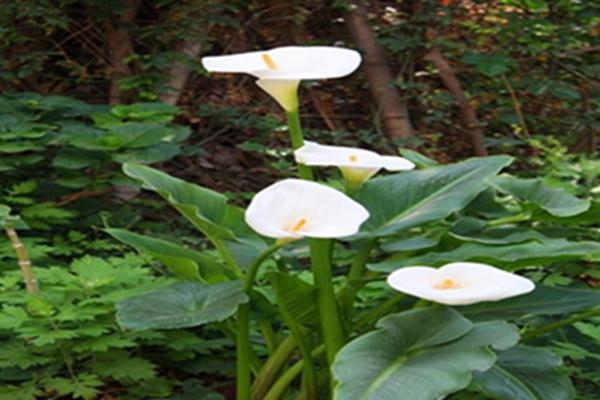
一、繁衍的方法
1、分球
这是它主要的繁衍方式,当它进入休眠期间的时候,我们需要把它块茎四周的小球形的植株给切下来,然后另行种植。
2、播种
这种方法需要我们等它的种子成熟以后将之采集,再进行播种,一般是种在屋内的盆中,让它发芽的温度要有十八到二十四度,等到十五到二十天后就可以发芽,一般种植后三个月就可以长出花来。
3、分株
等到五六月份长花以后,它的叶会慢慢的枯萎,然后会长出新的叶子。等到九月中旬给它更换新盆的时候,我们可以把它的母株附近的小茎给弄下来,然后给它上盆。

二、注意事项
1、如果是室外栽种的话,一般是在秋天以后再进行种植,两棵植株之间的距离要有二十五厘米,并且要用肥沃的发黏的土壤,一般用园土加上煤灰以及动物的粪便就可以。
2、在栽种之后给它盖上三四厘米厚的土,等到20天后就可以长出小苗。在成长期间,它喜欢充足的水分,我们需要经常给它的叶和周边的地面洒点水,并且要让它的叶保持干净。

3、它喜欢温暖湿润的区域,平时需要给它遮阴,在它长花的时候要给它充足的阳光,不然它的苞会带有绿色,对观赏不好。每天要给它三五个小时的光照,不然叶柄会长得很长,不太好看。
4、它对严寒的抵抗能力不是很强,等到十月中旬的时候要把它移到温房中,夏天除了要给它遮阴,还要给它喷水降温保持湿润。
5、它需要很大的肥,很大的水,在它成长期间要多给它浇水。可以用发酵过的化肥给它使用,每2个星期给它用一次,给它加肥的时候不要把肥撒在叶鞘中,不然它会腐烂。等到它的花蕾出现以后,要增加它的肥料,可以让它的花期变得更加的长,花更大,更加的好看。

0
1





